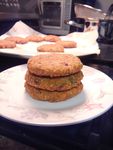According to the Canada's Food Price Report 2021, Canadians can expect to pay 3% to 5% more on groceries in 2021. This means for an average ...
←
→
Page content transcription
If your browser does not render page correctly, please read the page content below
J A N U A R Y
2 0 2 1
SURVIVING THE 2021 FOOD PRICE INCREASE
According to the Canada's Food Price Report 2021, Canadians can expect to pay 3% to 5% more
on groceries in 2021. This means for an average Canadian family of 4, they will pay an extra $695
for food. The increase comes from the COVID-19 pandemic, wildfires and changing consumer
habits. Here are some tips for saving money and surviving the 2021 food price increase:
Source: Canada's Food Price Report 2021
CHOOSE MORE FROZEN PRODUCE
The report predicts an increase of 4.5% to 6.5% for vegetables and 2% to 4% for fruits.
To save some money on produce, try choosing more frozen fruits and vegetables. These
frozen produce are snap frozen which means they are frozen at the point of harvest and
are just as nutritious as fresh fruits and vegetables, with the added bonus of being
cheaper. Frozen produce are picked when ripe and frozen right away, compared to fresh
produce that is picked before it's ripe and ripen on the truck - which may mean it hasn't
had the chance to set all the nutrients from the soil and sun in the ripening process. We
also throw away a lot of produce each year and if you feel like you're tossing away
vegetables that you don't eat each week, try buying them frozen instead.ADD LEGUMES FOR PROTEIN
The report predicts an increase of 4.5% to 6.5% for meat and 1.5% to 3.5% for seafood.
While these foods provide lots of protein, there are other ways to add protein to your
meals - Legumes! Legumes include chickpeas, beans and lentils. They are inexpensive
and nutritional powerhouses: high in protein and fibre. Canned - look out for ones that
are "low in sodium" and make sure you rinse them well before eating them. Dried - soak and cook them
yourself. Try adding them as substitutes in Sheppard's pie, lasagnas, meatballs and burgers, soups and stews,
puree them to make dips or spreads, add them to salads, the list goes on! You can also consider getting
protein from canned fish, which will be inexpensive and have a longer shelf-life in your kitchen. Look for
"canned in water" to reduce calories from the oils that some fish are kept in. If not, it's still okay to have the
ones "canned in oil".
LOOK FOR SALES
"If you fail to plan, you plan to fail." Look at grocery flyers before planning your meals for the
week. Use printed flyers or digital versions like the Flipp app to see flyers that have sales for the
future week. Shopping the flyers can help you plan your recipes for the week by knowing which
meats or vegetables are on sale and prevent you from buying unnecessary items that you don't
actually need. You can look for coupons on websites like Save.ca or SmartSource.ca. And
remember to check your pantry before going to the grocery stores because you may already
have items hidden in there.
Consider buying the marked-down produce, meat or bakery items to save dollars off your grocery bill. For
produce, once you cut off the bruised or blemished part, you can still use it. If you planned to cook a meat
within the time of the expiry date, you can use those items. Bakery items can also be frozen right away to
expand the shelf-life in your kitchen.
BUYING BULK
Bulk buying can save you a lot of money on a variety of items. You can pretty much buy bulk
for a lot of fresh foods and freeze them yourselves. For example, you can buy family packs of
meat and freeze them into individual portions, or dairy and freeze milk cartons. If you go to
Costco or buy in the bulk section of grocery stores, usually the larger sizes are more
inexpensive per gram or litre. The key to bulk buying is buying bulk on items you use regularly.
If you're trying a spice or oil for the first time, it's best to buy the small ones first.
HOW DID FOOD PRICES
COMPARE TO LAST YEAR'S
PREDICTIONS?
Source: Canada's Food Price Report 2021TUNA QUINOA PATTIES
PREP TIME
Prep 5 m | Cook 20 m | Total Time 25 m
Makes 8 servings
NUTRITION INFORMATION
INGREDIENTS
1/2 cup cooked, mashed sweet potato Per 1 serving (1 cake)
2 cans tuna, drained Calories 127
3/4 cup cooked quinoa Fat 2.6 g
1/4 cup green onion, chopped
Saturated 0.7 g
2 cloves garlic, minced
1 tbsp lemon juice Polyunsaturated 0.7 g
1 egg Monounsaturated 0.5 g
1/4 cup plain Greek yogurt Sodium 118.8 mg
1 tbsp mustard
Carbohydrates 15.5 g
1/2 tsp cayenne pepper
1 tsp paprika Fiber 1.8 g
1/2 cup bread crumbs Sugars 1 g
Protein 11.5 g
Vitamin A 66.1% Calcium 14.2%
PROCEDURE
Vitamin C 2.1% Iron 2.7%
1 Preheat oven to 400 °F (204 °C).
2
In a small bowl, combine tuna and sweet potato, mixing well.
Add remaining ingredients and stir until well combined.
3
4
Using your hands, form into 8 patties.
5
Place on a greased baking sheet and bake for 20 minutes, flipping once.
TIPS
Canned tuna is a great source of omega-3 fatty acids that can help protect against heart disease.
This recipe is packed with protein so you can enjoy them as a post-workout snack. You can eat
these patties plain, put them on a bun or add to salads for lunch or dinner. Try drizzling with
sriracha for a spicy kick or mix Thai chili sauce with plain yogurt for a dip. You can also substitute
tuna with canned salmon.You can also read
























































